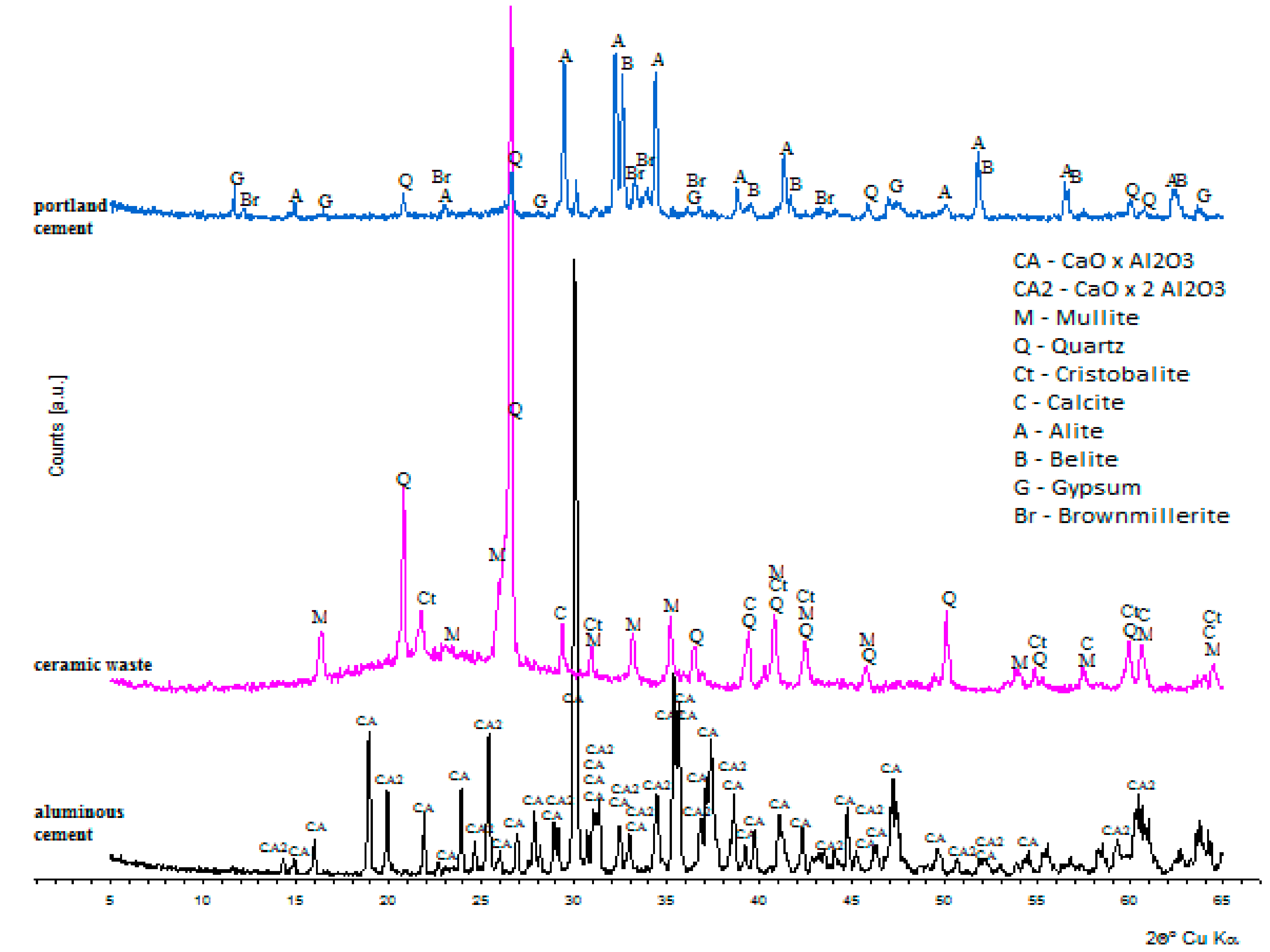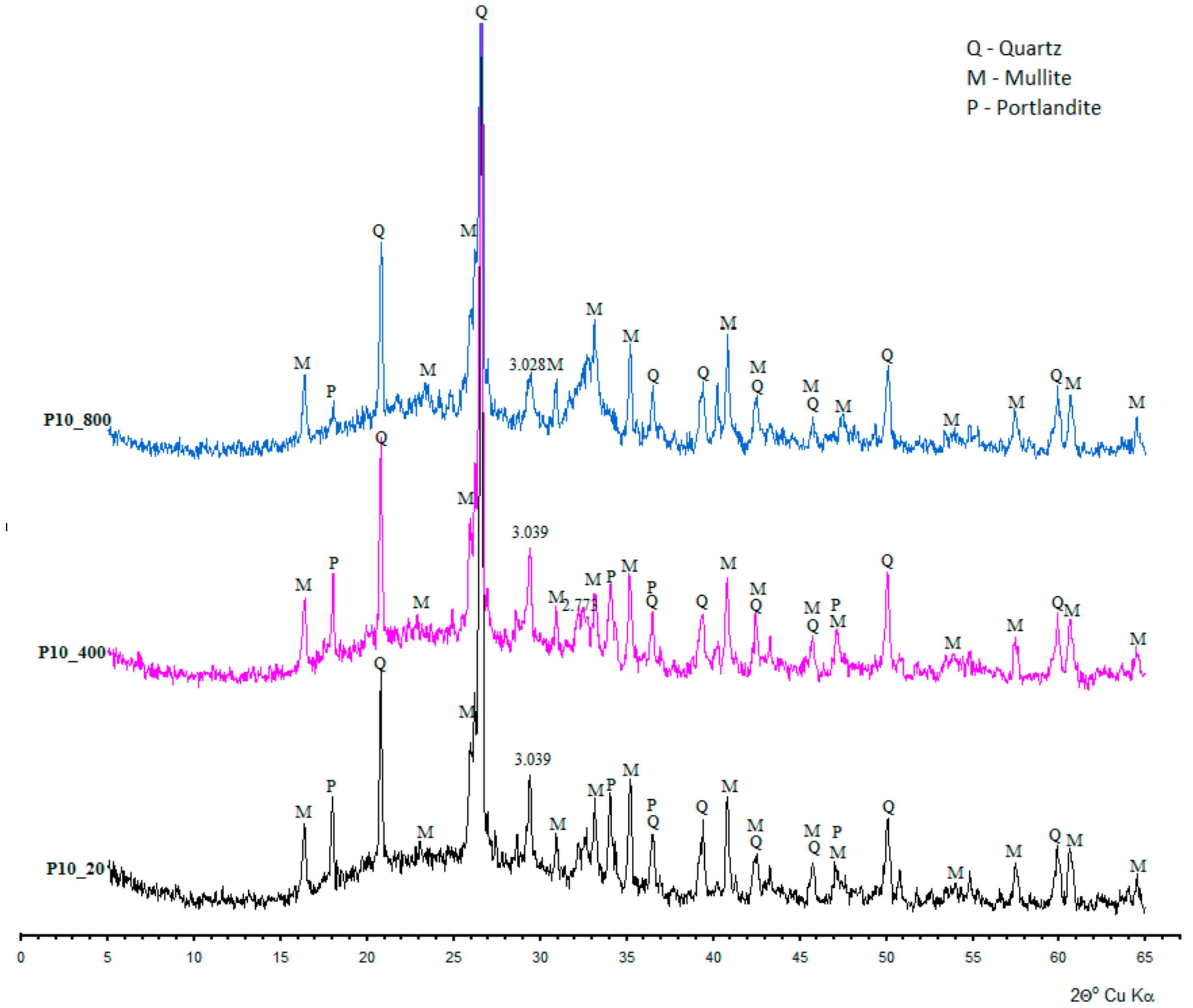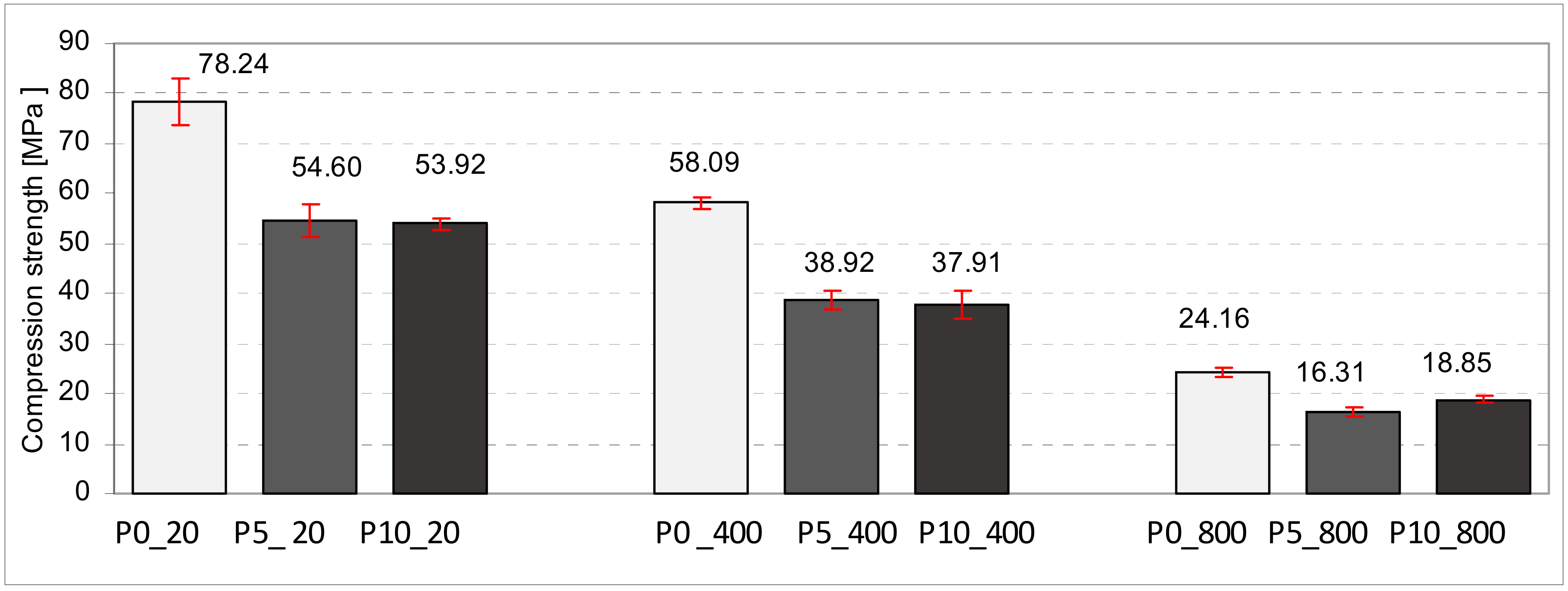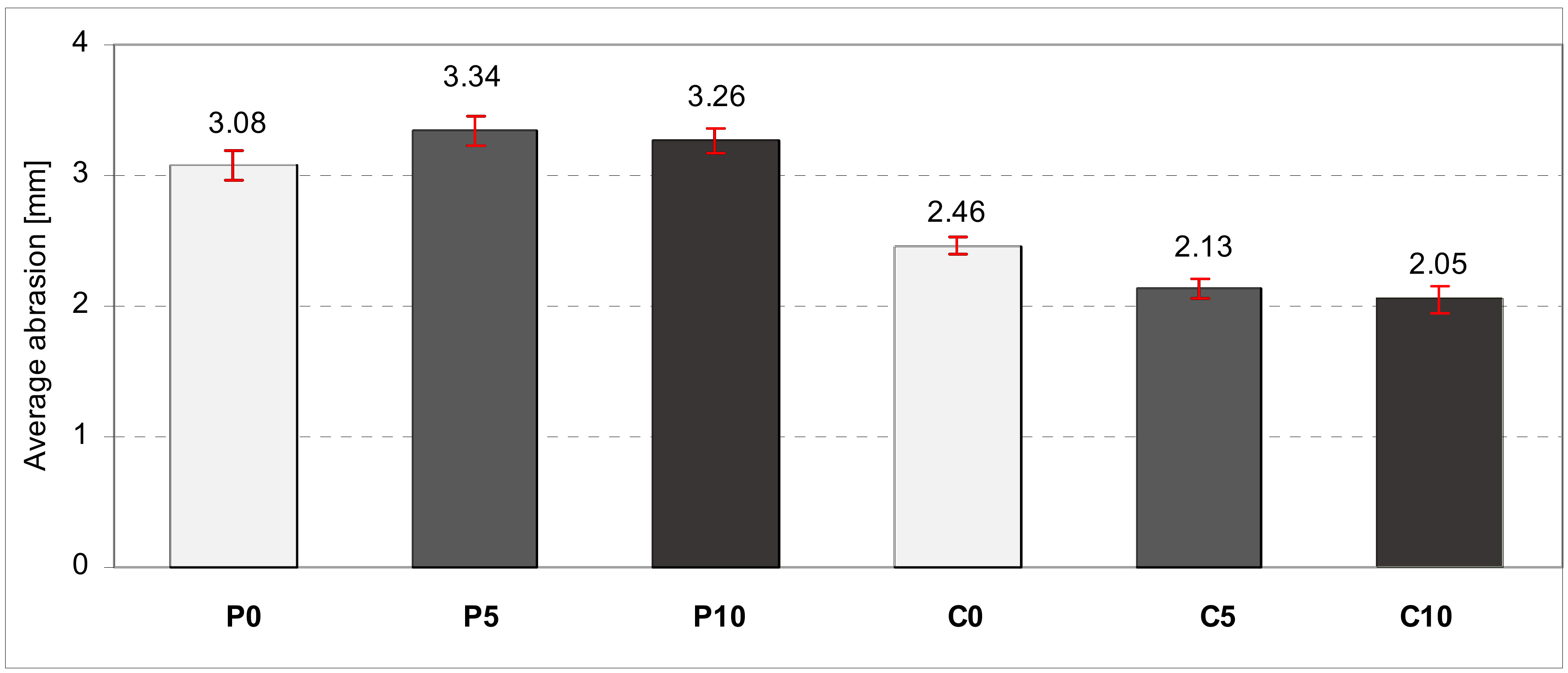The Wastes of Sanitary Ceramics as Recycling Aggregate to Special Concretes
Abstract
:1. Introduction
2. Materials and Methods
2.1. The Description of Concrete Samples Content and Research
2.1.1. Ceramic Cullet
2.1.2. Characteristics of Concrete Mix and Samples
2.1.3. Thermal Processing of Samples
- T—temperature (°C)
- t—time (min)
2.1.4. The Research on Abrasion and Compression Strength
3. Results
3.1. Characteristics of Ceramic Aggregates
3.2. Calcium Aluminate Cement
3.3. Phase Content and Microstructure of Concretes Containing Calcium Aluminate Cement and 10% of Aeration
3.4. The Values of Compression Strength and Abrasion Level of Concrete Samples
4. Conclusions
Author Contributions
Funding
Acknowledgments
Conflicts of Interest
References
- Motz, H.; Geiseler, J. Products of steel slags an opportunity to save natural resources. Waste Manag. 2001, 21, 285–293. [Google Scholar] [CrossRef]
- Mroueh, U.; Eskola, P.; Laine-Ylijoki, J. Life-cycle impacts of the use of industrial by-products in road and earth construction. Waste Manag. 2001, 21, 285–293. [Google Scholar] [CrossRef]
- Bromberek, Z. Energy efficiency and urban development. Izolacje 2014, 1, 14–18. (In Polish) [Google Scholar]
- Evangelista, L.; De Brito, J. Durability performance of concrete made with fine recycled concrete aggregates. Cem. Concr. Compos. 2010, 32, 9–14. [Google Scholar] [CrossRef] [Green Version]
- Kou, S.-C.; Poon, C.-S.; Wan, H.-W. Properties of concrete prepared with low-grade recycled aggregates. Constr. Build. Mater. 2012, 36, 881–889. [Google Scholar] [CrossRef]
- Gomez-Soberon, J.M.V. Porosity of recycled concrete with substitution of recycled concrete aggregate: An experimental study. Cem. Concr. Res. 2002, 32, 1301–1311. [Google Scholar] [CrossRef]
- Bolden, J.; Abu-Lebdeh, T.; Fini, E. Utilization of recycled and waste materials in various construction applications. Am. J. Environ. Sci. 2013, 9, 14–24. [Google Scholar] [CrossRef]
- Ahn, T.-H.; Kishi, T. Crack self-healing behavior of cementitious composites incorporating various mineral admixtures. J. Adv. Concr. Technol. 2010, 8, 180. [Google Scholar] [CrossRef]
- Abbas, A. Durability of Green Concrete as a Structural Material. Ph.D. Thesis, Department of Civil and Environmental Engineering, Carleton University, Ottawa, ON, Canada, 2007. [Google Scholar]
- DIN 4226-100:2002-02: Aggregates for Concrete and Mortar—Part 100: Recycled Aggregates; DIN Standards: Germany. Available online: https://www.beuth.de/de/norm/din-4226-100/44711226 (accessed on February 2002).
- BS 8500-2:2006+A1:2012. Concrete. Complementary British Standard to BS EN 206-1. Specification for Constituent Materials and Concrete; British Standards Institution (BSI): London, UK, 2006; Available online: https://shop.bsigroup.com/ProductDetail/?pid=000000000030274450 (accessed on 30 November 2006).
- PN-EN 12620+A1:2010. Kruszywa do Betonu. Aggregates for Concrete. Available online: http://sklep.pkn.pl/pn-en-12620-a1-2010p.html (accessed on 7 December 2010). (In Polish).
- Weil, M.; Jeske, U.; Schebek, L. Closed-loop recycling of construction and demolition waste in Germany in view of stricter environmental threshold values. Waste Manag. Res. 2006, 24, 197–206. [Google Scholar] [CrossRef] [PubMed]
- Anastasiou, E.; Filikas, K.G.; Stefanidou, M. Utilization of fine recycled aggregates in concrete with fly ash and steel slag. Constr. Build. Mater. 2014, 50, 154–161. [Google Scholar] [CrossRef]
- Pytel, Z. Characteristic features of ceramic materials containing waste moulding sand. Ceram. Mater. 2011, 63, 64–73. [Google Scholar]
- Adamson, M.; Razmjoo, A.; Poursaee, A. Durability of concrete incorporating crushed brick as coarse aggregate. Constr. Build. Mater. 2015, 94, 423–426. [Google Scholar] [CrossRef]
- Fadia, S.K. Use of crushed bricks as coarse aggregate in concrete. Tikrit J. Eng. Sci. 2009, 16, 64–69. [Google Scholar]
- Debieb, F.; Kenai, S. The use of coarse and fine crushed bricks as aggregate in concrete. Constr. Build. Mater. 2008, 22, 886–893. [Google Scholar] [CrossRef]
- Mansur, M.A.; Wee, T.H.; Charan, L.S. Crushed bricks as coarse aggregate for concrete. ACI Mater. J. 1999, 96, 478–484. [Google Scholar]
- Poon, C.S.; Kou, S.C.; Lam, L. Use of recycled aggregates in molded concrete bricks and blocks. Constr. Build. Mater. 2002, 16, 281–289. [Google Scholar] [CrossRef]
- Halbinika, J.; Ulewicz, M. Application of utilitarian and sanitary ceramics in cement mortars. Ceram. Mater. 2015, 67, 438–442. [Google Scholar]
- Binici, H. Effect of crushed ceramic and basaltic pumice as fine aggregates on concrete mortars properties. Constr. Build. Mater. 2007, 21, 1191–1197. [Google Scholar] [CrossRef]
- Guerra, I.; Vivar, I.; Liamas, B.; Juan, A.; Moran, J. Eco-efficient concretes: The effect of using recycled ceramic material from sanitary installations on the mechanical properties of concrete. Waste Manag. 2009, 29, 643–646. [Google Scholar] [CrossRef] [PubMed]
- García-González, J.; Rodríguez-Robles, D.; Juan-Valdés, A.; Morán-Del Pozo, J.M.; Guerra-Romero, M.I. Ceramic ware waste as coarse aggregate for structural concrete production. Environ. Technol. 2015, 36, 3050–3059. [Google Scholar] [CrossRef] [PubMed]
- Medina, C.; Sánchez De Rojas, M.I.; Thomas, C.; Polanco, J.A.; Frías, M. Durability of recycled concrete made with recycled ceramic sanitary ware aggregate. Inter-indicator relationship. Constr. Build. Mater. 2016, 105, 480–486. [Google Scholar] [CrossRef]
- Medina, C.; Frías, M.; Sánchez De Rojas, M.I. Microstructure and properties of recycled concretes using sanitary ware industry waste as coarse aggregate. Constr. Build. Mater. 2012, 31, 112–118. [Google Scholar] [CrossRef]
- Bakri, M.M.; Hussin, K.; Mohd, C.; Baharin, S.; Ramly, R.; Khairiatun, N. Concrete Ceramic Waste Slab (CCWS). J. Eng. Res. Educ. 2006, 3, 139–145. [Google Scholar]
- Senthamarai, R.M.; Manoharan, P.D.; Gobinath, D. Concrete made from ceramic industry waste: Durability properties. Constr. Build. Mater. 2011, 25, 2413–2419. [Google Scholar] [CrossRef]
- De Brito, J.; Pereira, A.S.; Correia, J.R. Mechanical behavior of non-structural concrete made with recycled ceramic aggregates. Cem. Concr. Compos. 2005, 27, 429–433. [Google Scholar] [CrossRef]
- Ogrodnik, P.; Zegardło, B.; Halicka, A. Preliminary assessment of utilization of sanitary ceramics wastes as an aggregate in concrete working at the high temperature. Saf. Fire Tech. 2012, 1, 49–56. [Google Scholar]
- Halicka, A.; Ogrodnik, P.; Zegardło, B. Using ceramic sanitary ware waste as concrete aggregate. Constr. Build. Mater. 2013, 48, 295–305. [Google Scholar] [CrossRef]
- Zegardło, B.; Ogrodnik, P. Analysis of destructive influence of water saturation on the strength of concrete subjected to fire. Saf. Fire Tech. 2016, 1, 27–35. [Google Scholar] [CrossRef]
- Ogrodnik, P.; Zegardło, B.; Radzikowska, M. The use of post-production sanitary ceramic waste as a filler for cement composites with high chemical resistance. Przemysł Chemiczny 2017, 96, 5. [Google Scholar] [CrossRef]
- PN-EN 933-1:2012. Badania Geometrycznych Właściwości Kruszyw—Część 1: Oznaczanie Składu Ziarnowego—Metoda Przesiewania. Polski Komitet Normalizacyjny: Poland. Available online: http://sklep.pkn.pl/pn-en-933-1-2012e.html (accesed on 19 July 2018). (In Polish).
- PN-B-06714-40:1978. Kruszywa Mineralne. Badania. Oznaczanie Wytrzymałości na Miażdżenie. Polski Komitet Normalizacyjny: Poland. Available online: http://sklep.pkn.pl/pn-b-06714-40-1978p.html (accessed on 19 July 2018).
- PN-EN 12350-7:2011. Badania Mieszanki Betonowej. Część 7. Badanie Zawartości Powietrza—Metody Ciśnieniowe. Polski Komitet Normalizacyjny: Poland. Available online: http://sklep.pkn.pl/pn-en-12350-3-2011p.html (accessed on 07 December 2009). (In Polish).
- PN-EN 1363-1:2012. Badania Odporności Ogniowej. Część 1. Wymagania Ogólne. Polski Komitet Normalizacyjny: Poland. Available online: http://sklep.pkn.pl/pn-en-1363-1-2012p.html (accessed on 17 February 2014). (In Polish).
- PN-EN 14157:2005. Kamień Naturalny—Oznaczanie Odporności na Ścieranie. Polski Komitet Normalizacyjny: Poland. Available online: http://sklep.pkn.pl/pn-en-14157-2005p.html (accessed on 12 December 2005). (In Polish).
- PN-EN 12390-3:2011. Badania Betonu. Część 3. Wytrzymałość na Ściskanie Próbek do Badania. Polski Komitet Normalizacyjny: Poland. Available online: http://sklep.pkn.pl/pn-en-12390-3-2011p.html (accessed on 19 July 2018). (In Polish).
- PN-EN 12390-4:2001. Badania Betonu Część 4. Wytrzymałość na Ściskanie. Wymagania dla Maszyn Wytrzymałościowych. Polski Komitet Normalizacyjny: Poland. Available online: http://sklep.pkn.pl/pn-en-12390-4-2001p.html (accessed on 19 July 2018). (In Polish).











| Group | Group I | Group II | ||||
|---|---|---|---|---|---|---|
| Marked samples | P0 | P5 | P10 | C0 | C5 | C10 |
| Calcium aluminate cement “Gorkal 70” (kg) | 488 | 488 | 488 | - | - | - |
| Portland cement 32.5 R (kg) | - | - | - | 488 | 488 | 488 |
| Aggregate 0–4 mm (kg) | 997.14 | 997.14 | 997.14 | 997.14 | 997.14 | 997.14 |
| Aggregate 4–8 mm (kg) | 398.86 | 398.86 | 398.86 | 398.86 | 398.86 | 398.86 |
| Water (L) | 199 | 199 | 199 | 199 | 199 | 199 |
| Aerating additive (kg) | - | 0.244 | 0.488 | - | 0.488 | 0.976 |
| Group | Portland Cement | Calcium Aluminate Cement | ||||
|---|---|---|---|---|---|---|
| Degree of concrete aeration | 0% | 5% | 10% | 0% | 5% | 10% |
| Basic samples not subjected to annealing 20 °C | P0_20 | P5_20 | P10_20 | C0_20 | C5_20 | C10_20 |
| Samples annealed in 400 °C | P0_400 | P5_400 | P10_400 | C0_400 | C5_400 | C10_400 |
| Samples annealed in 800 °C | P0_800 | P5_800 | P10_800 | C0_800 | C5_800 | C10_800 |
| Type of Aggregate | Compounds Content (%) | ||||||||
|---|---|---|---|---|---|---|---|---|---|
| SiO2 | Al2O3 | Fe2O3 | CaO | MgO | Na2O | K2O | TiO2 | Other | |
| Gravel | 16.7 | 8.0 | 1.0 | 31.8 | 40.8 | 0.9 | 0.8 | - | - |
| Granite | 74.8 | 14.2 | - | 1.6 | 0.6 | 5.6 | 2.8 | - | 0.4 |
| Red clay ceramics | 51.7 | 18.2 | 6.1 | 6.1 | 2.4 | 0.2 | 4.6 | 0.8 | 10.0 |
| Sanitary ceramics | 67.6 | 24.1 | 0.6 | - | 0.4 | 1.3 | 3.0 | - | 3.0 |
© 2018 by the authors. Licensee MDPI, Basel, Switzerland. This article is an open access article distributed under the terms and conditions of the Creative Commons Attribution (CC BY) license (http://creativecommons.org/licenses/by/4.0/).
Share and Cite
Ogrodnik, P.; Szulej, J.; Franus, W. The Wastes of Sanitary Ceramics as Recycling Aggregate to Special Concretes. Materials 2018, 11, 1275. https://doi.org/10.3390/ma11081275
Ogrodnik P, Szulej J, Franus W. The Wastes of Sanitary Ceramics as Recycling Aggregate to Special Concretes. Materials. 2018; 11(8):1275. https://doi.org/10.3390/ma11081275
Chicago/Turabian StyleOgrodnik, Paweł, Jacek Szulej, and Wojciech Franus. 2018. "The Wastes of Sanitary Ceramics as Recycling Aggregate to Special Concretes" Materials 11, no. 8: 1275. https://doi.org/10.3390/ma11081275






